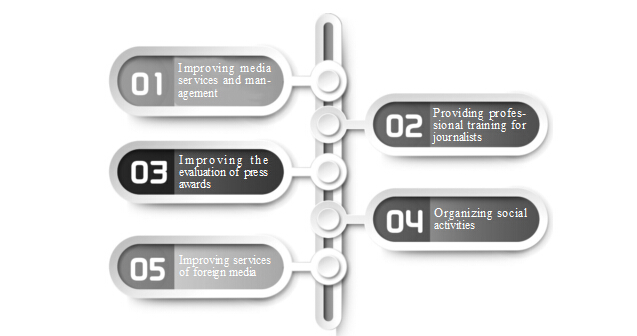The Press Environment
China practices a press public management system in light of its national conditions. The publicity department of the Communist Party of China (CPC), governmental institutions and press organizations have taken a variety of measures to improve services and management and regulate the order of the press work, so as to foster better environment and conditions for the development of the media industry and journalists.

1. Improving media services and management. China strives to improve its news media services and management, to ensure its long-term progress and cater to the country's actual needs. First, streamlining administrative examination and approval. At the end of 2015, a list of 52 items was issued for administrative examination and approval, including the establishment of publishing units and examination of homemade TV dramas and films. Nine items were removed. Second, improving transparency of the press. The state issued "Measures on Government Information Disclosure in the Press," stipulating that 10 types of information must be disclosed to the public; and the citizens, legal persons and other organizations can apply for relevant information in accordance with the law. Third, strengthening institutional building. On November 6, 2015, the SAPPRFT and the State Internet Information Office held a ceremony to present certificates to 594 journalists — the first to receive the certificate — from 14 news portals under the central government.
2. Providing professional training for journalists. China's 300,000 news reporters and editors received training and sat in related examinations organized by the SAPPRFT for the new journalist certificates. Press units under the central government and in different provinces, autonomous regions and municipalities directly under the central government held related training sessions by varied levels and in different genres, and sound training systems have been established at most press units. Efforts have been intensified in holding professional training courses to improve the press workers' professional skills. In 2013-14, People's Daily organized 23 training sessions in 19 categories for 5,375 persons; in 2014 Xinhua News Agency held 176 training sessions for 13,162 of its employees; and in 2015 China Central Television (CCTV) had 273 training sessions for 14,275 of its employees. The ACJA trained 293 teachers to add to the training staff at press units at all levels. Such training has laid a solid theoretical foundation for Chinese press workers to comprehensively and accurately master basic Marxist views of journalism to enhance the level of press report.
3. Improving the evaluation of press awards. China Journalism Awards and Changjiang-Taofen Awards are China's highest awards for news works and press workers. In 2014, an evaluation and appraisal committee was first established to audit and check the nominees and their works, disqualifying 149 works submitted for competition; to open up the channels for self-nominated works and works nominated by others, selecting and receiving 201 news works either submitted by the authors themselves or nominated by others, which accounted for one fifth of the submissions; and ruling that media organizations showing serious problems in fulfilling their responsibility for the public and reporters and editors with a record of poor ethics shall be disqualified from nomination.
4. Organizing social activities. At the end of 2014, a large-scale themed activity known by the name "China in Motion, Beautiful Stories," was held to encourage reporters to go deep into the grassroots for firsthand experience of life to tell well China's stories. A similar activity known by the name "Good Journalists Telling Good Stories" was held and it involved 12,000 journalists from around the country, who told moving stories about their interviews and daily work in addition to their new inspirations thus gained. Ultimately, the speeches by 10 best speakers were recorded into a special program and aired on CCTV on Chinese Journalists Day (November 8), winning warm applauses from all walks of life.
5. Improving services of foreign media. In 2015, the news center for the 70th anniversary of the Chinese People's War of Resistance Against Japanese Aggression and the World Anti-Fascist War hosted in total 4,339 journalists, of whom there were 1,596 foreign reporters from 430 media organizations of 70 countries and regions. Moreover, the news center gave six press conferences, sponsored five field trips and five cultural activities, and made arrangements for 1,000 Chinese and overseas journalists to cover the commemoration ceremony, and provided news information services and facilities to their interviews and news dispatches. During the 2014 APEC Economic Leaders' Meeting, China set up for the first time two news centers (one at the National Convention Center and one at Yanqihu), providing services to 4,060 reporters, including 1,859 from 504 media organizations in 61 countries.
Viewed from the perspective of the media, all media organizations have, in view of their own practical needs, explored for flexible and efficient talent-training and incentive mechanisms to open up more space for the development of their reporters and editors by offering the platforms to appeal and retain talent.
